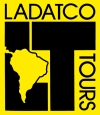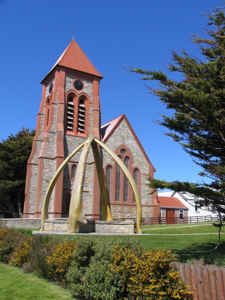
Custom Designing Pampered Adventure since 1966

Destinations
Experiences
 |
L A D A T C
O T O U R S Custom Designing Pampered Adventure since 1966 |
 |
||||||||
| HOME | South America | Falkland Islands | Antarctica | Unique Destinations |
Unique Experiences |
Newsstand | ||||
 |
FALKLAND ISLANDS Stanley |
 |
Capital of the Falkland Islands, and with a population of around 2,000 it is the smallest and most remote capital city in the world, in many ways like an English village, but with a Government House, a Cathedral and a wide range of amenities and services. It is the usual finishing (and/or starting) point for visitors to the Falklands.
The city is built on a north-facing slope to catch the sun throughout the year, and looks across Stanley Harbour with its wealth of seabirds and shipping. It has much of historical interest mainly associated with the days when great sailing ships and early steam vessels called on their journeys around Cape Horn. Some of those ships still lie in the harbour, abandoned after a Cape Horn battering. A self-guided Maritime History Trail has been set up in Stanley and guide books are available from local shops.
Today Stanley depicts a new vibrant Falklands, and is home to many successful businesses, with deep-sea fishing, tourism and farming being the principle earners.
The harbor at Stanley is the greatest graveyard of 19th century shipping in the world. Along the seven mile harbor front can be seen the hulks of some twenty ships that were beaten into submission by Cape Horn and never left the Falklands. A sign-posted walk points out many of the wrecks including the East Indiaman "Jhelum" (built in 1839) and the North Atlantic packet ship "Charles Cooper" (the last US sailing packet to sail out of New York harbor and in the Islands since 1866). At the east end of the harbor lies the iron "Lady Elizabeth", 228 feet long with three masts still standing.Day Excursions
from Stanley
Stanley is an ideal location from which to access other areas of East Falkland. A firm favourite is the King penguin colony at Volunteer Point or the wildlife centres at Cape Bougainville and Cape Dolphin. A bit closer to home the area known as Cape Pembroke and in particular Gypsy Cove are popular attractions particularly with day visitors disembarking from cruise ships. Our extremely knowledgeable and qualified guides will make battlefield tours of the mountains to the west of Stanley, or further afield to Fitzroy, Darwin or San Carlos a truly enjoyable day out.
Views of Stanley from the harbour, with its colourful roofs, make for excellent photographic opportunities so it is always worth taking time to enjoy a wreck and harbour tour or a trip to Kidney Cove penguin colonies by small motorised launch. Often dolphins can be seen swimming alongside the boat, making this an extra special outing.
|
||||||||||||||||||||||
| ACCOMMODATIONS: The main
hotel in Stanley is the Malvina House Hotel, located on Ross Road. Malvina Felton gave her name to the original Malvina House back in the 1890's. The modern Malvina House, built in the late 1960's, was converted into a hotel in 1983 and has been extensively renovated. All 18 rooms have en-suite bathrooms with "power shower"; there is a large bar-lounge area and the original Conservatory houses the restaurant, considered the best in town. |
|